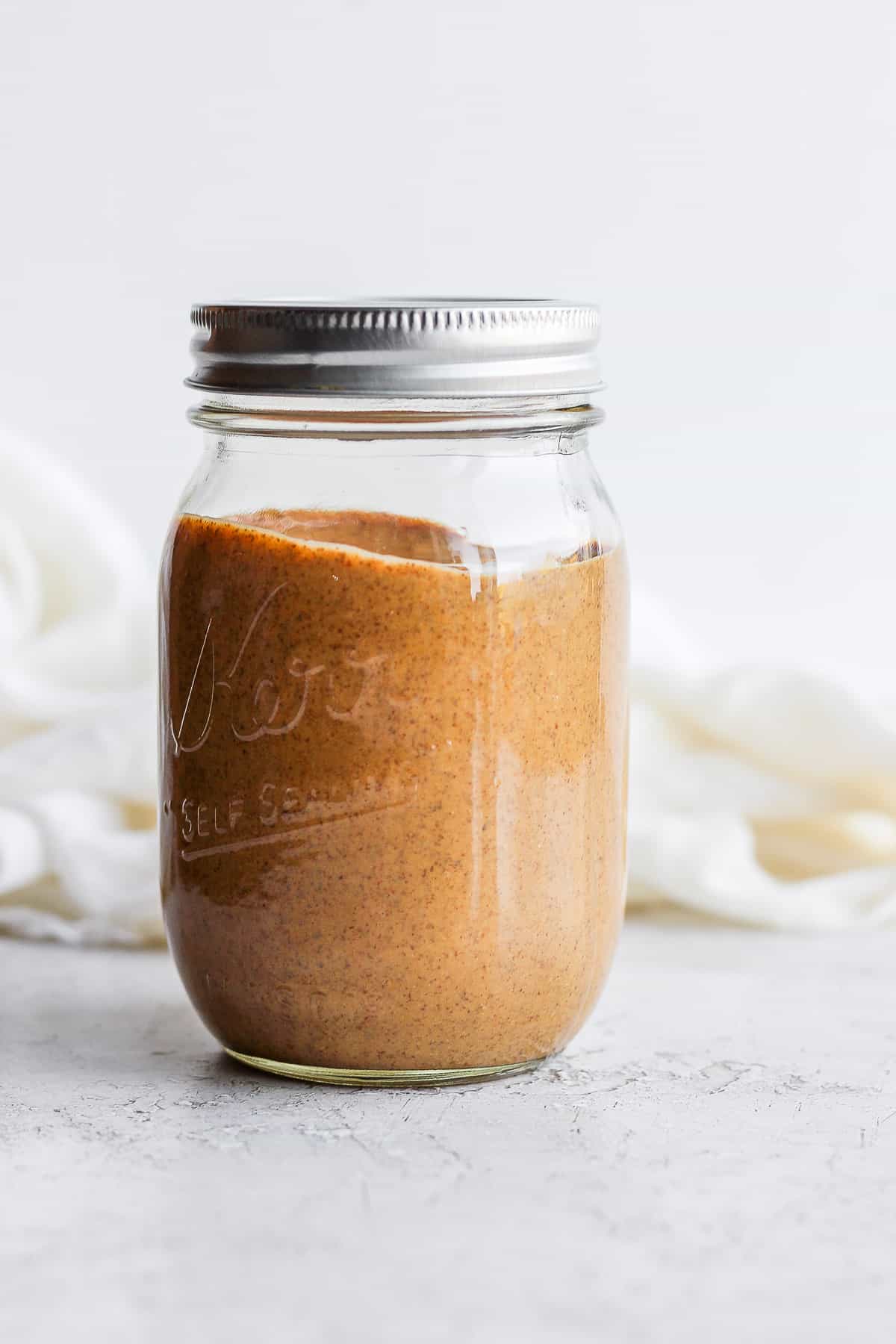Homemade Almond Butter
Updated Nov 26, 2024
This is a step-by-step tutorial for how to make your own homemade almond butter with a food processor including tips, guidelines and add-ins!
This post may contain affiliate links. Please read our disclosure policy.
Did you know you only need nuts and a food processor to make your own nut butter? When I figured out how to make almond butter, it was like a lightbulb moment. It’s so easy and way more cost-effective (especially if you’re like me and can easily spend $12 on a jar of nut butter!). Plus, with homemade almond butter, you customize the chunkiness level and pick your own add-ins like cinnamon, honey, or chocolate chips!

Jump to Section
I love almond butter. I’ll eat it on oatmeal, slathered onto toast, with slices of apple, or straight from the jar with a spoon! This recipe needs just two ingredients and basically just requires turning on the food processor until the almonds break down and turn into butter. Sometimes, I like to add cinnamon, vanilla, or honey. Other times, I’ll stir in chocolate chips or toasted coconut flakes! There’s no way to go wrong.
Recipe At a Glance
Cuisine Inspiration: American
Primary Cooking Method: No-cook
Dietary Info: Vegan and gluten-free
Key Flavor: Creamy, salty, nutty
Skill Level: Easy
Why This Is So Good
- Fast: It takes just 10 minutes in a food processor to make almond butter!
- You can make as much as you want: I like to make a large batch since I go through it quickly, but you could always halve this recipe.
- Tastes better than store-bought: This DIY nut butter tastes nuttier and way more almond-y than anything you can buy.

Ingredients to Make Almond Butter
- Almonds: First, for the purest product, start with raw, unsalted almonds. That way, you control the salt and oil in your almond butter. Pre-salted nuts could make for too-salty nut butter!
- Salt: Try the recommended amount in the recipe below and then adjust to your taste! Remember: You can always add salt, but you can’t subtract it.
Popular Additions
- Add in sweetener. If you want to sweeten things, add honey, agave syrup, or maple syrup.
- Try spices. Spice-wise, try cardamon, cinnamon, pumpkin spice, or even hot pepper flakes for something savory.
- Add some texture. Mix in chia seeds, flaxseeds, or a handful of other kinds of nuts.
- Make it chocolatey. Mix in cocoa powder or stir in chocolate chips!
How to Make Homemade Almond Butter
Below, I’ll walk you through how to make your own almond butter. Spoiler alert: it’s super simple. As in just toasting the nuts and letting the food processor do the rest of the work!




Tips for Making the Best Homemade Almond Butter
- Use the freshest nuts. These make the best nut butter, and the resulting almond butter will have a longer shelf life.
- Watch the nuts in the oven. Burnt nuts taste acrid–and nuts burn easily! The moment you start smelling toastiness, remove the almonds immediately from the oven.
- Be super patient. Achieving creamy nut butter takes a while, even in the best food processor. It could take up to 10 minutes to get the right consistency.
- Use this two-step method if you love chunky nut butter. First, set aside a scoop of the ground-up almonds when they’re at that granular, wet-sand stage. At the end of processing, mix this in.
- Add your own oil. For spreadable nut butter, add a bit of a neutral oil—like peanut or avocado. Start with a very small amount, about one teaspoon.
Recipes That Use Almond Butter
- Healthy Rice Krispie Treats
- Blueberry Banana Smoothie
- Almond Butter Chocolate Chip Cookies
- Banana Date Smoothie
- Honey & Cinnamon Spiced Almond Cake
- Spicy Almond Butter Noodles
- Almond Butter Sandwich
- Baked Apple Donuts with Almond Butter Glaze
- Spicy Almond Butter Chicken Curry
- Almond Butter & Jam Cupcakes
- Fudgy Flourless Almond Butter Brownies
Frequently Asked Questions
For long storage, yes. And it will last in the refrigerator for up to 6 months. If you prefer warm almond butter and go through it quickly, you can store it in the pantry.
Yes, actually! It will never freeze solid because of its high fat content, but for smoothies, it is great right from the freezer. Expect it to last up to a year if stored in an airtight container.
Yes, you can, but I recommend a high-speed blender. Here’s how to make almond butter in a blender: add the nuts and salt to a blender and blend, using the blender’s tamper to push the nuts toward the blades as necessary and scraping the sides of the blender as needed.

More Cooking Tutorials
- How to Make Oatmeal
- How to Make Peanut Butter
- How To Make Oat Flour
- How to Make a Flax Egg
- How to Poach an Egg Perfectly
- How to Cut an Avocado
- How to Cook Dry Chickpeas
- How to Cut a Head of Lettuce
- How to Cut Cauliflower into Florets
If you try this feel good Homemade Almond Butter recipe or any other recipe on Feel Good Foodie, then don’t forget to rate the recipe and leave a comment below! It helps others who are thinking of making the recipe. We would love to hear about your experience making it. And if you snapped some shots, share it on Instagram so we can repost on Stories!

Homemade Almond Butter
Ingredients
- 3 cups whole almonds skin on
- ¼ teaspoon salt
Instructions
- Preheat oven to 275°F. Place the almonds on a baking sheet and toast for 20-25 minutes, turning halfway through.
- Transfer the warm almonds from the baking sheet into a food processor fitted with the metal blade along with the salt.
- Blend until a smooth homogeneous paste forms, stopping to scrape down the sides as needed. It could take up to 10 minutes depending on your food processor.
Equipment
Notes
Nutrition
Nutrition information provided is an estimate. It will vary based on cooking method and specific ingredients used.
Photo Credit: Erin Jensen






Comments
I definitely will do the almond butter, sounds easy and no preservatives, bonus.
Yes! Let me know what you think once you do!